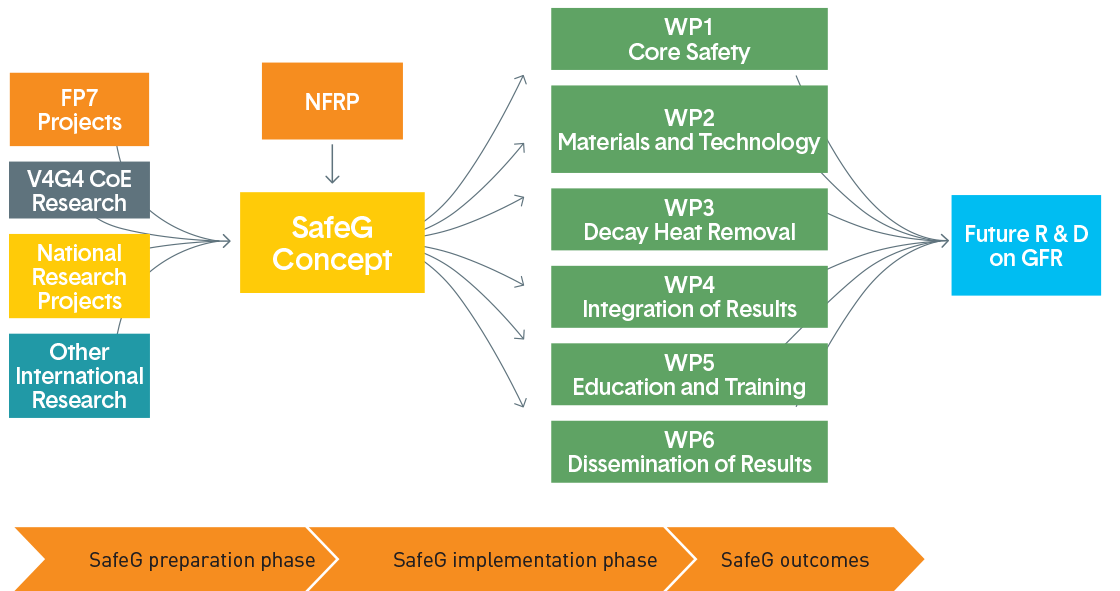Structure of the Project Activities
WP 1 - Core safety, proliferation resistance
The general objective of the WP1 is to strengthen safety of the GFR core and the nuclear fuel in particular.
Some of the activities are expected, due to budget constraints, to be focused exclusively on ALLEGRO, some are of a more general nature and will serve GFR development in general.
Main objectives of this WP can be summarized as:
- Core safety, through optimized neutronic, thermal-hydraulic and thermomechanics design of the core
- Proliferation resistance – assessment of current status of the reference GFR options from this point of view recommendations for further improvements
- Safe core shutdown – by design of passive, reliable core control and shutdown system
WP2 - Innovative Materials and Technologies for Enhancing Safety of GFRs
Within the WP2, introduction of innovative processes, materials and technologies into the design of GFRs, and ALLEGRO in particular, will be performed, and their effects on safety and performance of the reactor will be evaluated. Main objectives of this WP can be summarized as following:
- To solve the weak points of selected key components with respect to materials and safety in the primary circuit and DHR circuit
- To test compatibility of selected materials and components with GFR coolant
- To propose and assess adequate innovative materials with better performance as well as the advanced manufacturing processes and technologies
WP3 - Innovative solutions for decay heat removal
The main objective of the WP3 is to verify and optimize solutions of decay heat removal, based on the reference concepts, as well as the design of new innovative decay heat removal strategies and systems. Specific objectives are following:
- Better understanding of complex phenomena related to decay heat removal in GFRs, based on the use of experimental facilities and state-of-the art CFD and system code analyses
- Optimization of reference concepts by building on experience with design of GFRs
- Design of innovative solutions of key safety systems and components related to decay heat removal in GFRs
WP4 - Integration of the results, standardization, codes
The WP4 will serve to integrate the results achieved elsewhere in the project. It will also connect the consortium and the outer world concerning R&D, legislation, standardization and codes. It gives a wider framework to WP1-WP3. Main objectives are:
- Integration of results of the project
- Identification of R&D needed in future projects, to build on results of SafeG
- Existing standards and codes, as well as those currently under preparation, will be analysed with respect to needs of GFR design gaps will be identified, and effort will be put into closing these gaps.
WP5 - Education and Training
Education and training activities within this project will be heavily focused on on-job training of students and young professionals. The goal is to involve them in solving of actual cutting-edge research problems, and to attract new students by offering interesting Ph. D. and masters theses with a clear connection to application of their results. The second part of this WP is focused on organization of several events that will help to achieve goals described above. A thermal-hydraulics benchmark will be organized, focused on Ph. D. students and young professionals, as well as two workshops including hands-on activities.
WP6 - Dissemination and outreach
The overall objective of the WP6 is to strengthen the impact of the project on relevant stakeholders. It will be achieved by:
- Dissemination of project results to targeted professional audiences (operators of infrastructures and related institutes, similar projects, organizations dealing with nuclear education including universities running courses on nuclear technologies) and general public with focus on youth,
- Communication with relevant stakeholders and decision makers (ministries, policy-makers, international organisations, funding agencies, nuclear technology platforms, etc.) as well as
- Outreach to potential beneficiaries.
WP7 - Project management
The main objectives of WP7 are:
- To assure efficient management of SafeG project activities including overall project steering, follow up of the project schedule, deliverables and milestones as well as the processes leading to them. Other important aspects such as overall legal, contractual, ethical, financial and administrative management of the project and management of the project’s decision-making processes to respect relevant standards are also handled here.
- To ensure cooperative research on technical tasks with quality control;
- To assure internal and external (to the EC) reporting, communication, risk management and knowledge management within the partnership
- To organize project meetings and steering of the project management bodies
The whole concept of the SafeG project is graphically interpreted below.

